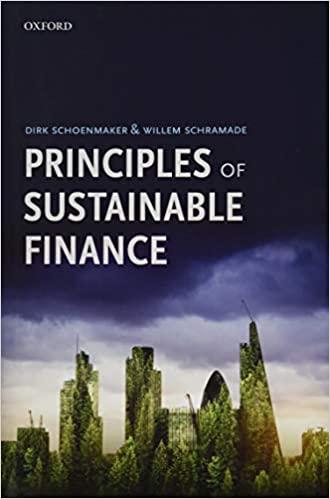Question
Your investment strategy is to maximize expected return but with a risk level (standard deviation) that does not exceed 15%. Since you are a CAPM
Your investment strategy is to maximize expected return but with a risk level (standard deviation) that does not exceed 15%. Since you are a CAPM believer, you hold a combination of the market portfolio and risk free asset. The market expected return in 10% with a standard deviation of 20% and the risk free rate is 3%.
(A) What portfolio do you hold?
ANSWER (A)
Answer: The portfolio would consist of 75% market portfolio and 25% risky asset.
The Standard deviation of a portfolio containing a risky asset (here the market portfolio) and a risk free asset is given by the formula
Standard deviation of the Portfolio = Weight of the risky asset * Standard deviation of the risky asset.
For the porfolio to have a risk level of 15% (std deviation) the weight of the market portfolio can be solved from
the equation 15 = Wt of the risky asset * 20 ; Wt of the risky asset = 15/20 = 0.75.
Therefore the portfolio would consist of 75% market portfolio and 25% risky asset.
The expected return would be 0.75*10 + 0.25*3 = 8.25%.
Derivation of the formula for a portfolio with a risk free asset.
 w12
w12 12 + w22
12 + w22 22 + 2w1w2
22 + 2w1w2 12 , where w1 and w2 are weights of the two assets,
12 , where w1 and w2 are weights of the two assets,  1 and
1 and  2 their standard deviations and
2 their standard deviations and  12 the correlation of thier returns.
12 the correlation of thier returns.
As the standard deviation of the risk free asset is 0, the equation would get reduced to  w2
w2 2
2
of the risky asset. Hence, the standard deviation of the portfolio = weight of the risky asset in the portfolio * standard deviation of the risky asset.
NASA has just announced that it not only found water on MARS but it also plans to open a resort on MARS named MARS for Life. NASA wishes to sell the new venture to investors in an initial public offering (IPO). An analyst estimates expected profits (Revenues Expenses) would be $1B one year from now. The analysts mention that these are the expected profits and the risk (standard deviation) of this venture is 30% and the correlation with the market is 0.2. For simplicity we assume that this is a 1 year project where all revenues and expenses occur 1 year from now.
Q: 1 In the public offering NASA plans to sell 50M shares. What is the maximal share price at which you will invest in the new venture?
ANSWER Q:1
Standard Deviation = 30%
Correlation with Market = 0.2
Required rate of return (R) = 0.2*30% = 6%
Net Cash Flows after 1 year = $1 Billion
To calculate future value of net cash flows, we have to discount the net cash flows with R
Future Value of net cash flows = 1,000,000,000/(1.06)
= $943,396,226
Thus the future value of cash flows available to all shareholders = $943,396,226
No of shares = 50,000,000
Thus the future value of cash flows available for each share = $943,396,226/50,000,000 = $18.87
Thus, the maximum price at which i will invest in teh venture is $18.87 per share
Q: 2 Suppose that the price for MARS for Life is 10% lower than your answer in Q: 1. How would your answer to Part (A) change? What portfolio would you hold?
PLEASE ONLY ANSWER Q:2 . I INCLUDED THE ANSWERS OF PART A AND Q:1 GIVEN BY CHEGG EXPERTS PREVIOUSLY ON MY POSTS FOR THE REFERENCE FOR ANSWERING Q:2
Step by Step Solution
There are 3 Steps involved in it
Step: 1

Get Instant Access to Expert-Tailored Solutions
See step-by-step solutions with expert insights and AI powered tools for academic success
Step: 2

Step: 3

Ace Your Homework with AI
Get the answers you need in no time with our AI-driven, step-by-step assistance
Get Started


